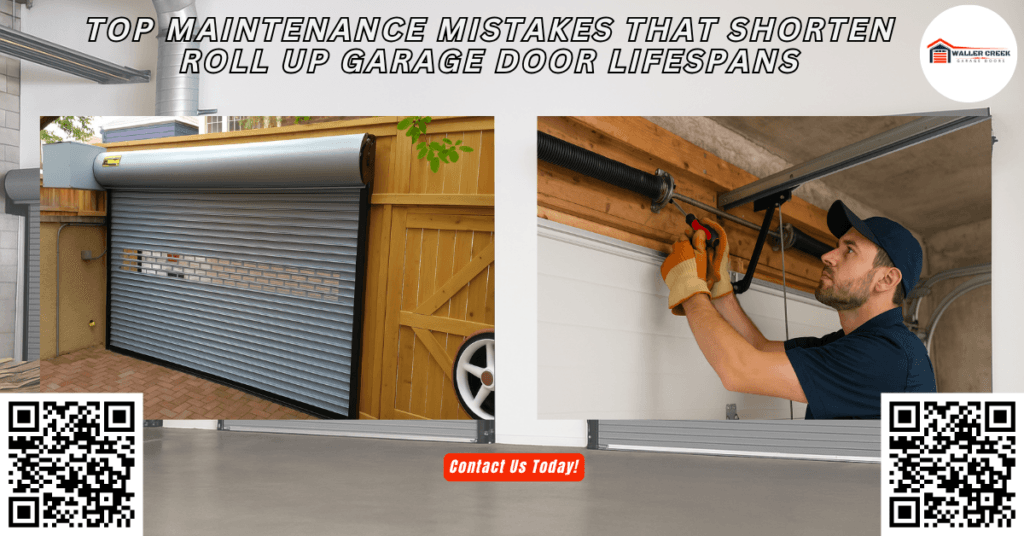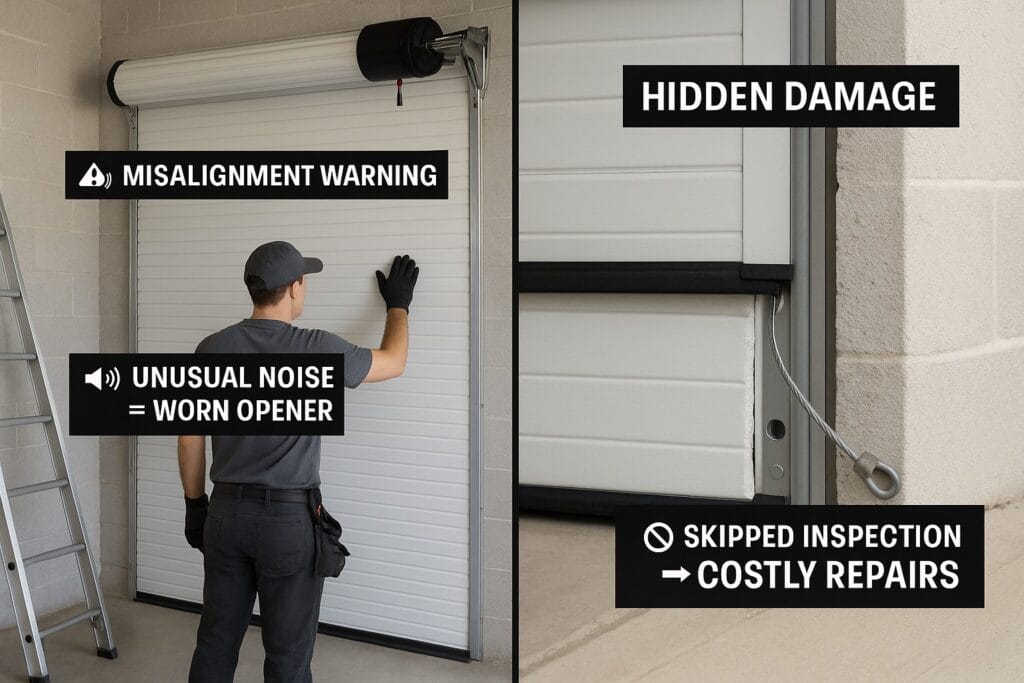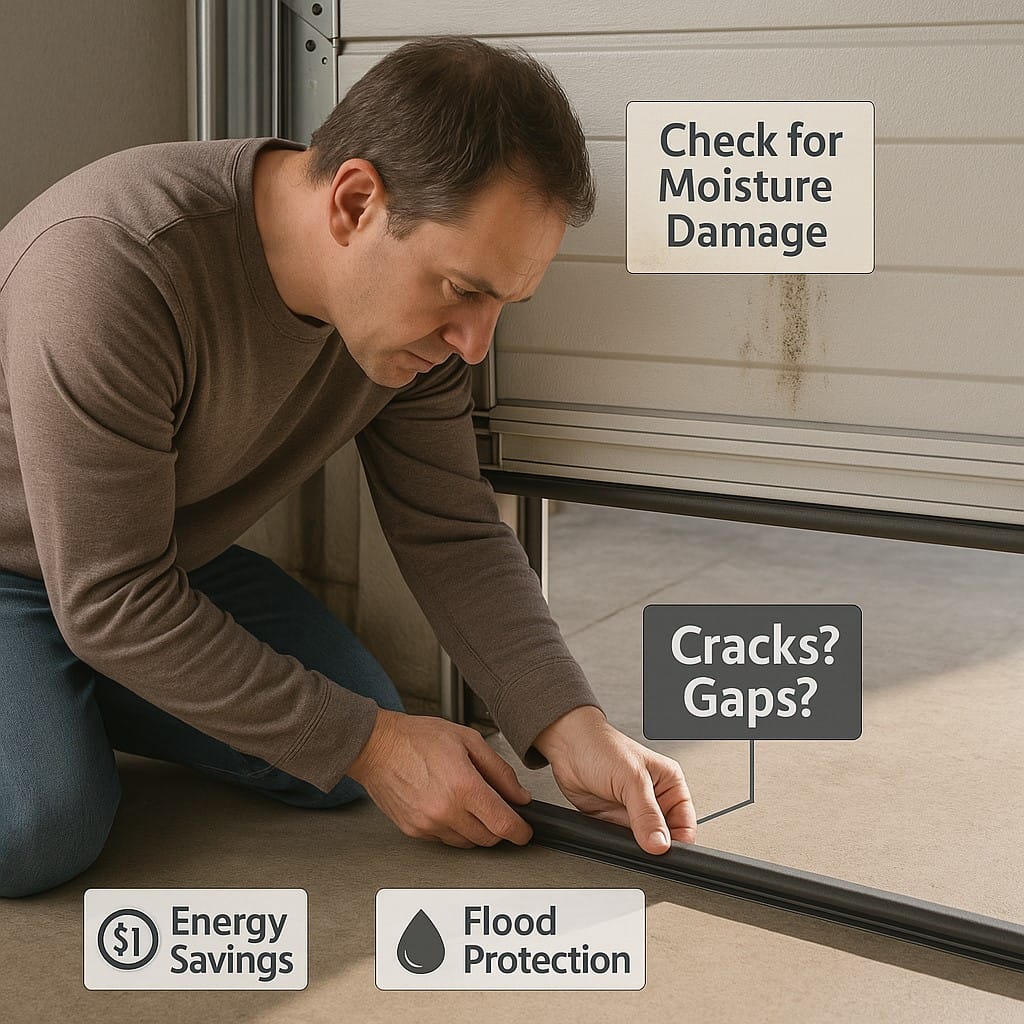Top Maintenance Mistakes That Shorten Roll-Up Garage Door Lifespans

By Waller Creek Garage Doors – Your Local Experts in Austin, TX
In the heart of Austin, we recently helped a homeowner whose insulated roll-up garage door stopped working just as the summer heat peaked. The culprit? Layers of dust, worn-out polyurethane insulation, and a rusty spring that hadn’t been checked in years. This is just one of many calls we get where proper maintenance could’ve prevented the problem and saved the homeowner time, money, and stress.
Did you know that poor maintenance can reduce your garage door’s lifespan by nearly 30%? Whether you own a steel roll-up door in Round Rock or a foam-insulated door in Cedar Park, the most common issues we often see come down to neglect. And in a climate like Texas, with its extreme summer heat and chilly winter nights, maintaining your garage door and its insulation is crucial not just for longevity but for energy efficiency and temperature control too.
At Waller Creek Garage Doors, we specialize in helping homeowners and businesses across Austin and surrounding areas get the most from their garage door investments. Let’s break down the top maintenance mistakes that shorten roll-up garage door lifespans and what you can do to avoid them.
1. Skipping Regular Garage Door Inspections
A roll-up garage door may look sturdy, especially if it’s made from steel, aluminum, or reinforced with foam panels, but small issues can quickly add up when ignored.

Why It’s a Problem
Minor problems like uneven movement, misaligned insulated panels, or a loud opener often signal hidden wear. If left untreated, these can lead to expensive breakdowns.
What You Should Do
Perform a visual and physical inspection every three months. Look for:
- Gaps in insulation material
- Rust or warping, especially on aluminum doors
- Excessive noise from the garage door opener
- Loose or cracked urethane weather seals
2. Ignoring the Role of Garage Door Insulation
In Austin’s blazing summers, a poorly insulated garage can become a heat trap. Not only is it uncomfortable, but it can also affect your home’s energy bills and indoor temperature.
Why It’s a Problem
Neglecting garage door insulation reduces energy efficiency, increases thermal transfer, and causes your air conditioning system to work harder.
What You Should Do
Inspect the foam or fiberglass insulation inside your door panels. Replace or upgrade if:
- You notice peeling or crumbling insulation kits
- You have a non-insulated garage door that feels extremely hot or cold
- Your R-value is below the recommended level for Austin’s climate (R-12 to R-18)
Consider switching to polyurethane foam or polystyrene core panels for better heat insulation and energy savings.
3. Not Cleaning Tracks and Sensors
Dust, dirt, and debris build up quickly in the tracks of roll-up garage doors, especially in areas like East Austin or near construction zones.
Why It’s a Problem
Dirty tracks cause friction, strain the opener motor, and misalign the door. If the photo-eye sensors are dirty, your door might refuse to close or reverse unexpectedly.
What You Should Do
- Use a dry cloth or soft brush to clean the tracks monthly
Gently clean sensors with a microfiber cloth - Avoid spraying water directly near the logic board or electrical connections
4. Skipping Lubrication for Moving Parts
Parts like rollers, springs, and hinges need regular lubrication to move smoothly.
Why It’s a Problem
Without proper lubrication, moving parts wear down quickly, increasing the chances of a jam or spring failure.
What You Should Do
Use a garage-specific lubricant on:
- Rollers and hinges
Tracks and pulleys - Garage door opener chains or belts
Do this every six months, especially before summer or winter, to avoid weather-related strain.
5. Ignoring Weather Stripping and Seals
Your garage door’s bottom seal and side weatherstripping act as a barrier against rain, pests, and temperature changes.
Why It’s a Problem
Worn seals allow heat and moisture to enter, reducing energy efficiency and promoting rust or foam degradation in insulated garage doors.
What You Should Do
- Inspect seals for cracks, gaps, or brittleness
- Replace weatherstripping at least once a year or when daylight seeps in
Choose urethane or silicone-based products for Texas weather

6. Leaving Small Problems Unchecked
Strange noises, slow response, or a slightly tilted door are often brushed off as “normal wear.”
Why It’s a Problem
What starts as a misaligned garage door panel can escalate into a broken track or failed insulation barrier.
What You Should Do
Don’t ignore these signs:
- The door doesn’t open or close fully
- Slanted or sagging door sections
- Loud screeching or humming from the opener motor
These issues often require quick professional attention.
7. Attempting DIY Repairs on High-Tension Components
Watching DIY videos may make fixing your garage door springs or opener look easy, but these components are under high tension and can be dangerous.
Why It’s a Problem
Improper repairs can damage the door, break the insulated panels, or cause serious injury.
What You Should Do
Call professionals for:
- Spring or cable replacement
- Garage door opener logic board troubleshooting
- Track realignment or door leveling
8. Overlooking the Impact of Temperature Extremes
Garage doors in Austin face a lot from scorching summer heat to humid, stormy winters.
Why It’s a Problem
Extreme temperatures affect the integrity of foam, styrofoam, and fiberglass insulation, especially if not properly rated for your region.
What You Should Do
- Choose doors with high R-values and low U-values for better performance
- Use garage door insulation kits to enhance existing doors
- Upgrade to insulated sectional doors with thermal barriers if your door is outdated
9. Not Upgrading When It’s Time
Many homeowners wait until their door completely fails before upgrading. But if you have an old steel door with no insulation or cracked foam core, it may be costing you more than you think.
What You Should Do
If your door is over 15 years old and lacks:
- Proper insulation materials
- A modern garage door opener
- Energy-efficient features like weather seals and thermal barriers
…it’s time to consider an upgrade.
Look for:
- Craftsman garage doors, Amarr garage doors, or Clopay garage doors
- Smart-enabled openers
- Doors with built-in polyurethane foam or rigid batt insulation
How Can Waller Creek Garage Doors Help You?
Whether you need a garage door tune-up, an insulated door installation, or an upgrade to a smart garage door opener, Waller Creek Garage Doors is your go-to provider in Austin, TX.
Why Choose Us?
- 🛠️ Skilled technicians with years of experience in garage door insulation and opener repair
- 💡 We work with steel, aluminum, fiberglass, and all major insulation types
- 🧰 Custom solutions for homes, car garages, and commercial properties
- 🌡️ We help improve energy efficiency with the right insulated garage door for your space
- 💬 Free consultations and honest quotes
📍 Visit Us: 816 Tirado St, Austin, TX 78752
📞 Call Now: (512) 642-5669
Don’t let small mistakes cost you a big investment! Call Waller Creek Garage Doors today to schedule your inspection, maintenance, or upgrade and enjoy a longer-lasting, more efficient, and better-looking garage door.
Frequently Asked Questions
1. How long should a roll-up garage door last with proper maintenance?
With regular maintenance, a quality roll-up garage door can last 15 to 30 years, depending on materials and usage frequency.
2. What is the best insulation type for garage doors in hot climates like Austin, TX?
Polyurethane foam offers the highest R-value and is best for Texas heat due to its superior thermal resistance and air-sealing properties.
3. Can I add insulation to an existing roll-up garage door?
Yes, insulation kits like rigid foam or reflective barriers can be added to many existing doors to improve energy efficiency.
4. How often should I service my roll-up garage door professionally?
It’s recommended to have a professional inspection and tune-up at least once a year, or sooner if you notice performance issues.
